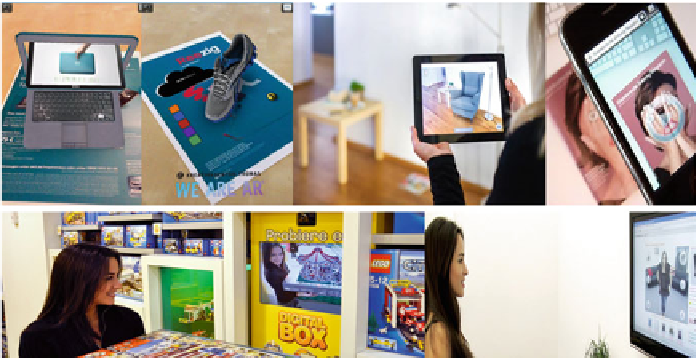Graphics Reference
In-Depth Information
Fig. 7.5
Virtual information overlay, virtual fitting, and retail AR applications
at a dashboard component. The app snapshot shown in the top right image of Fig.
7.4
recognizes over 300 individual elements of Audi A3, from the insignia on the wind-
shield wipers and entertainment system to actual engine components under the hood.
It also returns relevant how-to information or even virtual overlays of maintenance
instructions, animated in real-time and in 3D [
15
]. Cloud-based architecture pushes
digital information directly to the device, meaning the user will never have to update
the app. Using 2D and 3D tracking technology, the user positions the camera of the
mobile device directly over the individual vehicle elements, instantly detecting and
returning information on the desired subject. For example, after scanning the engine
compartment, the app returns information and an animated overlay showing how to
locate the engine coolant and refill it to the appropriate level.
Onestepupincomplexityis
Virtual Fitting
like apps where the augmentation has
to be really precise and to scale. Examples are shown in Figs.
7.5
,
7.6
and
7.7
.To
fit 3D furniture models to scale into a real home environment 3D feature tracking
and monocular SLAM is used as shown in the third image in the top row of Fig.
7.5
.
With the inclusion of 3D depth cameras this application will be better and precise
due to the accurate scale and occlusion information as shown later in Fig.
7.12
.The
application shown in the bottom left image of Fig.
7.5
relies on 2D image tracking
approach to recognize the different LEGO boxes and visualizes the 3D animations to
the corresponding LEGO model. Children can now hold LEGO packaging up to the
“digital box” and watch a 3D animation of the product from any angle and in every
detail—all in their hands. The technology not only creates a fascinating technical
experience, but also gives retailers a unique selling pitch while helping to inform
interested customers. Examples of carmaintenance applications are shown in Fig.
7.6
.
For reliable project planning, the installation of the new engine needs to be simulated
in advance, saving time and money. Using AR visualization in the virtual positioning
and mounting of the new engine as shown in the top right image in Fig.
7.7
is based

